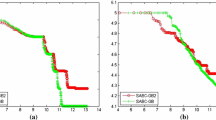Abstract
A popular optimization algorithm, the artificial bee colony algorithm (ABC), has attracted great attention over the recent years for its powerful global search ability. However, its slow convergence rate limits its development. In this paper, to further enhance its performance, we first introduced a new concept of a leading group, which includes some individuals with excellent performance, into the traditional ABC. The updated bee then selects one individual from the group to follow, which accelerates the convergence rate of the population. Furthermore, to enable the ABC algorithm to acquire greater opprotunities to search within a larger space, a logistic chaotic operator was introduced into our algorithm to balance its global and local search abilities. The performance of the algorithm proposed is tested on the traditional 12 benchmark functions and an image registration problem. The results reveal that our algorithm provides more acceptable results compared with the other algorithms.












Similar content being viewed by others
References
Ali MM, Khompatraporn C, Zabinsky ZB (2005) A numerical evaluation of several stochastic algorithms on selected continuous global optimization test problems. J Glob Optim 31:635–672
Ayatollahi F, Shokouhi SB, Ayatollahi A (2012) A new hybrid particle swarm optimization for multimodal brain image registration. J Biomedical Science and Engineering 5:153–161
Babaoglu I (2015) Artificial bee colony algorithm with distribution-based update rule. App. Soft. Comput. 34:851–861
Cui LZ, Li GH, Li Z et al (2016) A novel artificial bee colony algorithm with depth-first search framework and elite-guided search eqaution. Inform. Sciences 367-368:1012–2044
Cui LZ, Zhang K, Li GH (2017) Modified gbest-guided artificial bee colony algorithm with new probability model. Soft Comput 1:1–27
Falco ID, Cioppa AD, Maisto D, Tarantino E (2008) Differential evolution as a viable tool for satellite image registration. Appl Soft Comput 8(4):1453–1462
Gao WF, Liu S, Huang L (2013) A novel artificial bee colony algorithm based on modified search equation and orthogonal learning. IEEE T Syst Man Cybern 43(3):1011–1024
Gao L, Guo Z, Zhang H, Xu X, Shen HT (2017) Video captioning with attention-based lstm and semantic consistency. IEEE Trans on Multimedia 19(9):2045–2055
Huimin L, Bin L, Junwu Z et al (2017) Wound intensity correction and segmentation with convolutional neural networks. Concurrency and Computation: Practice and Experience. https://doi.org/10.1002/cpe.3927
Karaboga D (2005) An idea based on honey bee swarm for numerical optimization. Technical report-tr06, Erciyes University, Engineering Faculty, Turkey
Karaboga D, Gorkemli B (2014) A quick artificial bee colony (qABC) algorithm and its performance on optimization problems. App. Soft. Comput. 23:227–238
Kıran MS, Fındık O (2015) A directed artificial bee colony algorithm. App. Soft. Comput. 26:454–462
Kiran MS, Hakli H, Gunduz M et al (2015) Artificial bee colony algorithm with variable search strategy for continuous optimization. Inform Sciences 300:140–157
Kuang F, Jin Z, Xu W, et al. (2014) A novel chaotic artificial bee colony algorithm based on tent map. in Proc. IEEE Congr. Evol. Comput.: 235–241
Li X, Yang G (2016) Artificial bee colony algorithm with memory. App. Soft. Comput. 41:362–372
Li X, Yang G, Kıran MS (2016) Search experience-based search adaptation in artificial bee colony algorithm. IEEE Congress on Evolutionary Computation (CEC’2016), IEEE, Vancouver: 2524–2531
Lu H, Li Y, Uemura T, Ge Z, Xu X (2017) FDCNet: filtering deep convolutional network for marine organism classification. Multimedia Tools & Application 2:1–14
Mases F, Collgnon A, Vandermeulen D, Marchal G, Suetens P (1997) Multimodality image registration by maximization of mutual information. IEEE Trans Med Imaging 16(2):187–198
May RM (1976) Simple mathematical models with very complicated dynamics. Nature 261(5560):459–467
Shi Y, Eberhart R (1998) A modified particle swarm optimizer. IEEE World Congress on Computational Intelligence. IEEE, Alaska 69–73
Simon D (2008) Biogeography-based optimization. IEEE Trans Evol Comp 12(6):702–713
Song X, Yan Q, Zhao M (2017) An adaptive artificial bee colony algorithm based on objective function value information. App Soft Comput 55:384–401
Storn R, Price K (1997) Differential evolution–a simple and efficient heuristic for global optimization over continuous spaces. J Glob Optim 11(4):341–359
Wachowiak M P, Smolikova R, Z. Y F, Zurada J M and Elmaghraby A S (2004) An approach to multimodal biomedical image registration utilizing particle swarm optimization. IEEE Trans Evol Comput 8 (3): 289–301
Xu X, He L, Sshimada A, Taniguchi RI, Lu H (2016) Learning unified binary codes for cross-modal retrieval via latent semantic hashing. Neurocomputing 213:191–203
Xu X, Shen F, Yang Y, Shen HT, Li X (2017) Learning discriminative binary codes for large-scale cross-modal retrieval. IEEE Trans Image Process 26(5):2494
Xu X, He L, Lu H, Gao L, Ji Y (2018) Deep adversarial metric learning for cross-modal retrieval. World Wide Web. https://doi.org/10.1007/s11280-018-0541-x
Yao X, Liu Y (1999) Evolutionary programming made faster. IEEE Trans Evol Comput 3:82–102
Yue X, Jiang JM, Zhao BP, Ma TH (2017) A self-adaptive artificial bee colony algorithm based on global best for global optimization. Soft Comput 22(9):2935–2952
Zhang Q, Wen G J, Zhang C X, Lin Z R, Shang Z M, Wang H M (2014) Image registration with position and similarity constraints based on genetic algorithm. 2014 10th International Conference on Natural Computation (ICNC’2014), IEEE, Xiamen: 568–572
Zhu G, Kwong S (2010) Gbest-guided artificial bee colony algorithm for numerical function optimization. Appl Math Comput 217(7):3166–3173
Acknowledgments
This work was partially supported by the National Nature Science Foundation of China (No. 61571236, 61690210, 61690215), the Research Committee of University of Macau (MYRG2015-00011-FST, MYRG2018-00035-FST), the Science and Technology Development Fund of Macau SAR under Grant 041-2017-A1, Funded by Science and Technology on Space Intelligent Control Laboratory, No. KGJZDSYS-2018-02, Postgraduate Research & Practice Innovation Program of Jiangsu Province (SJCX18_0300, KYCX18_0929).
Author information
Authors and Affiliations
Corresponding author
Additional information
Publisher’s Note
Springer Nature remains neutral with regard to jurisdictional claims in published maps and institutional affiliations.
Rights and permissions
About this article
Cite this article
Hu, H., Pun, CM., Liu, Y. et al. An artificial bee algorithm with a leading group and its application into image registration. Multimed Tools Appl 79, 14643–14669 (2020). https://doi.org/10.1007/s11042-019-7211-6
Received:
Revised:
Accepted:
Published:
Issue Date:
DOI: https://doi.org/10.1007/s11042-019-7211-6




